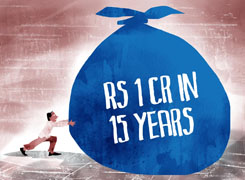Will 4.5 CR suffice for retirement at 58 with daughter's marriage and son's education/marriage?
Ramalingam Kalirajan |10874 Answers |Ask -Follow
Mutual Funds, Financial Planning Expert - Answered on Mar 10, 2025
He has an MBA in finance from the University of Madras and is a certified financial planner.
He is the director and chief financial planner at Holistic Investment, a Chennai-based firm that offers financial planning and wealth management advice.... more

Is 4.5 CR at age of 58 is enough for retirement. Liabilities are(a) marriage of daughter (b) Education and marriage of son.
Step 1: Understanding Your Retirement Expenses
Retirement expenses can be divided into two categories: essential and discretionary.
1. Essential Expenses
Day-to-day expenses like food, utilities, and transportation.
Healthcare costs, including insurance premiums and medical treatments.
Inflation-adjusted expenses, which may double every 15 years.
2. Discretionary Expenses
Leisure activities like travel, hobbies, and entertainment.
Home maintenance and renovation costs.
Additional expenses such as gifts, social commitments, and festivals.
Step 2: Major Financial Liabilities Before and After Retirement
You have major expenses related to your daughter and son.
1. Daughter’s Marriage
Marriage expenses can vary widely based on personal choices.
Consider factors like venue, jewelry, gifts, and ceremonies.
Plan to invest separately for this goal to avoid reducing retirement savings.
2. Son’s Education and Marriage
Higher education costs are rising significantly every year.
If he plans to study abroad, costs can be even higher.
Marriage expenses will depend on cultural and personal preferences.
Investing in a dedicated portfolio for this goal will help manage costs.
Step 3: Evaluating Your Corpus Against Inflation
Inflation will erode the purchasing power of your Rs 4.5 crore.
A comfortable retirement today may not be sufficient 20 years later.
Healthcare inflation is higher than regular inflation.
Your investment strategy should ensure consistent cash flow post-retirement.
Step 4: Investing to Preserve and Grow Retirement Corpus
Investing correctly can ensure your corpus lasts through retirement.
1. Keep a Balanced Investment Portfolio
Maintain 60-70% in equity mutual funds for long-term growth.
Keep 30-40% in fixed-income instruments for stability.
A Certified Financial Planner (CFP) can help in portfolio allocation.
2. Avoid Index Funds and ETFs
Index funds do not actively manage risks.
Actively managed funds adjust portfolios based on market conditions.
Professional fund management helps in better returns and risk control.
3. Stay Away from Direct Funds
Direct funds require continuous tracking and market knowledge.
Investing through a Certified Financial Planner with MFD credentials ensures better planning.
Regular funds provide expert management and timely rebalancing.
Step 5: Managing Healthcare Costs in Retirement
Medical expenses will be one of the biggest costs in retirement.
Maintain a strong health insurance policy.
Keep an emergency healthcare fund for medical costs.
Consider investing in a separate fund for future medical needs.
Step 6: Generating a Steady Income Post-Retirement
Your corpus must generate regular income while also growing over time.
Withdraw only a small percentage each year to ensure longevity.
Keep a mix of growth and stability-oriented investments.
A proper withdrawal strategy prevents early depletion of funds.
Finally
A Rs 4.5 crore corpus may or may not be enough, depending on expenses and inflation. Your daughter’s marriage, son’s education, and rising medical costs require a structured financial plan. Investing wisely in actively managed funds, avoiding index and direct funds, and maintaining a proper withdrawal strategy can help you sustain a comfortable retirement.
Best Regards,
K. Ramalingam, MBA, CFP
Chief Financial Planner
www.holisticinvestment.in
https://www.youtube.com/@HolisticInvestment
You may like to see similar questions and answers below
Milind Vadjikar | Answer |Ask -Follow
Insurance, Stocks, MF, PF Expert - Answered on Sep 30, 2024
Milind Vadjikar | Answer |Ask -Follow
Insurance, Stocks, MF, PF Expert - Answered on Dec 24, 2024
Naveenn Kummar |233 Answers |Ask -Follow
Financial Planner, MF, Insurance Expert - Answered on Sep 11, 2025
Ramalingam Kalirajan |10874 Answers |Ask -Follow
Mutual Funds, Financial Planning Expert - Answered on Sep 17, 2025
Mayank Chandel |2569 Answers |Ask -Follow
IIT-JEE, NEET-UG, SAT, CLAT, CA, CS Exam Expert - Answered on Dec 08, 2025
Mayank Chandel |2569 Answers |Ask -Follow
IIT-JEE, NEET-UG, SAT, CLAT, CA, CS Exam Expert - Answered on Dec 08, 2025

Mayank Chandel |2569 Answers |Ask -Follow
IIT-JEE, NEET-UG, SAT, CLAT, CA, CS Exam Expert - Answered on Dec 08, 2025
Mayank Chandel |2569 Answers |Ask -Follow
IIT-JEE, NEET-UG, SAT, CLAT, CA, CS Exam Expert - Answered on Dec 08, 2025
Mayank Chandel |2569 Answers |Ask -Follow
IIT-JEE, NEET-UG, SAT, CLAT, CA, CS Exam Expert - Answered on Dec 08, 2025
Anu Krishna |1746 Answers |Ask -Follow
Relationships Expert, Mind Coach - Answered on Dec 08, 2025
Ramalingam Kalirajan |10874 Answers |Ask -Follow
Mutual Funds, Financial Planning Expert - Answered on Dec 08, 2025
Samraat Jadhav |2499 Answers |Ask -Follow
Stock Market Expert - Answered on Dec 08, 2025
Ramalingam Kalirajan |10874 Answers |Ask -Follow
Mutual Funds, Financial Planning Expert - Answered on Dec 08, 2025
Radheshyam Zanwar |6737 Answers |Ask -Follow
MHT-CET, IIT-JEE, NEET-UG Expert - Answered on Dec 08, 2025













.jpg)











